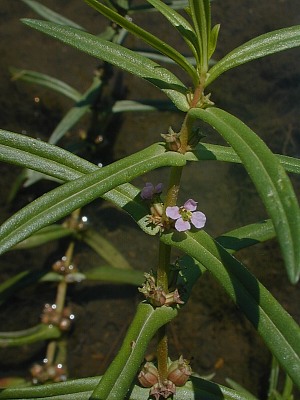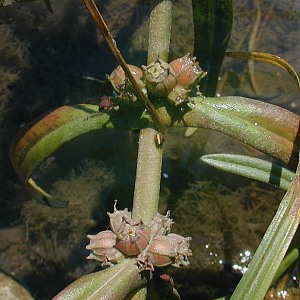Description:
This
plant is a summer annual that often branches at the base,
otherwise it is usually unbranched. The erect or sprawling stems are
about ½–1' long. They are light green, glabrous, and either round or angular in
circumference. Pairs of opposite leaves occur at intervals along these
stems. They are up to 2½" long, ¼" across, linear or linear-lanceolate,
smooth along the margins, and glabrous. Each leaf clasps the stem at
the base, where it often has a pair of small shallow lobes (i.e., it is
auriculate). Along the upper surface of each leaf, there is a
conspicuous central vein that runs along its length. From 1-7 flowers
are produced in tight clusters in the upper axil of each leaf. These
flowers are sessile, or nearly so. Usually, fewer flowers are produced
per axil in the upper leaves (about 1-3) than in the lower leaves
(about 3-7). Each flower is about ¼" across, consisting of 4 rounded
petals that are pink or purple, a tubular calyx that is divided into 4
segments that form ridges at their edges, 4 or 8 stamens with yellow
anthers, and a stout central style. The calyx is initially green or
purple, but it later becomes red when the seeds begin to ripen. In the
middle of each calyx segment, there is a secondary ridge along its
length; these 4 secondary ridges are slightly less pronounced than the
4 primary ridges between the segments of the calyx. The blooming period
occurs from mid-summer to early fall and lasts about 2-3 months.
Individual flowers are short-lived. An ovoid seed capsule develops
within the surrounding calyx that causes it to swell in diameter. This
capsule contains numerous tiny seeds that are shiny and yellow. These
seeds are small enough to be blown about by the wind, and they probably
float on water. The root system consists of a shallow tuft of roots.
This plant spreads by reseeding itself.
round or angular in
circumference. Pairs of opposite leaves occur at intervals along these
stems. They are up to 2½" long, ¼" across, linear or linear-lanceolate,
smooth along the margins, and glabrous. Each leaf clasps the stem at
the base, where it often has a pair of small shallow lobes (i.e., it is
auriculate). Along the upper surface of each leaf, there is a
conspicuous central vein that runs along its length. From 1-7 flowers
are produced in tight clusters in the upper axil of each leaf. These
flowers are sessile, or nearly so. Usually, fewer flowers are produced
per axil in the upper leaves (about 1-3) than in the lower leaves
(about 3-7). Each flower is about ¼" across, consisting of 4 rounded
petals that are pink or purple, a tubular calyx that is divided into 4
segments that form ridges at their edges, 4 or 8 stamens with yellow
anthers, and a stout central style. The calyx is initially green or
purple, but it later becomes red when the seeds begin to ripen. In the
middle of each calyx segment, there is a secondary ridge along its
length; these 4 secondary ridges are slightly less pronounced than the
4 primary ridges between the segments of the calyx. The blooming period
occurs from mid-summer to early fall and lasts about 2-3 months.
Individual flowers are short-lived. An ovoid seed capsule develops
within the surrounding calyx that causes it to swell in diameter. This
capsule contains numerous tiny seeds that are shiny and yellow. These
seeds are small enough to be blown about by the wind, and they probably
float on water. The root system consists of a shallow tuft of roots.
This plant spreads by reseeding itself.
Cultivation:
The preference is full sun, wet conditions, and muddy soil. The seeds
germinate better if they are temporarily submerged in water, and then
left in muddy soil. This emulates their natural habitat.
Range & Habitat:
The native Scarlet Toothcup is an occasional to locally common plant in
most areas
of Illinois, except in the upper two tiers of counties, where it is
largely absent (see Distribution
Map). Habitats include muddy shores of ponds, mud flats along
rivers, ditches, limestone quarries, and grassy areas that are prone to
occasional flooding. This species tolerates disturbs conditions in
wetlands.
Faunal Associations:
The nectar of the flowers attracts various insects, including small
bees (Little Carpenter, Halictid), Syrphid flies, Tachinid flies, and
small- to medium-sized butterflies (Whites, Sulfurs, & others).
The bees also collect pollen. The seed capsules are eaten by ducks
during the fall and winter, including Anas platyrhynchos
(Mallard), Anas acuta (Northern Pintail), and Anas
crecca (Green-Winged Teal). The foliage is not known to be
toxic, and it is probably eaten by Branta canadensis
(Canada Goose).

Photographic
Location:
Along the muddy shore of a pond in Champaign, Illinois.
Comments:
The common name, 'Scarlet Toothcup,' refers to the appearance of the
fruits when they begin to ripen during the fall. Another common name
for this species is 'Purple Ammannia,' which refers to the color of the
flowers. Scarlet Toothcup is a wetland species that is not very showy
and often overlooked, although it is useful as a source of food for
waterfowl. The only other species in this genus that occurs in
Illinois, Ammannia robusta (Robust Toothcup), was
formerly regarded as a subspecies of Scarlet Toothcup, or Ammannia
coccinea robusta. However, genetic analysis has revealed that
it is a distinct species. Robust Toothcup occurs primarily in NE
Illinois and has an appearance that is similar to Scarlet Toothcup. The
petals of its flowers are light pink to pink and there are only 1-3
flowers (or seed capsules) per leaf axil, whereas Scarlet Toothcup has
flower petals that range from pink to purple and there are often 3-5
flowers (or seed capsules) per axil among the lower leaves (and
sometimes even more). Another wetland species in the Loosestrife family
with a similar appearance is Rotala ramosior
(Wheelwort). Unlike the preceding Toothcup species, Wheelwort has only
a single flower or seed capsule per leaf axil, and the petals of its
flowers are white. Whereas the Toothcup species have leaves that clasp
their stems, the leaves of Wheelwort are sessile.